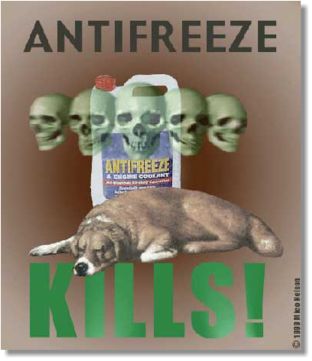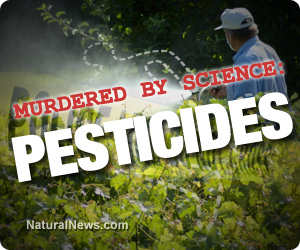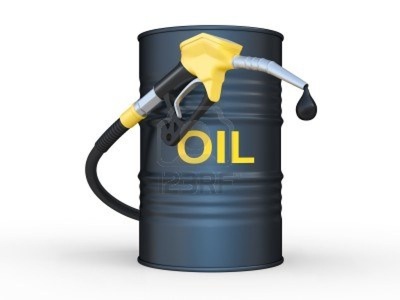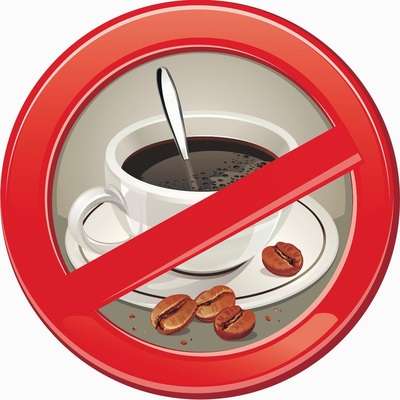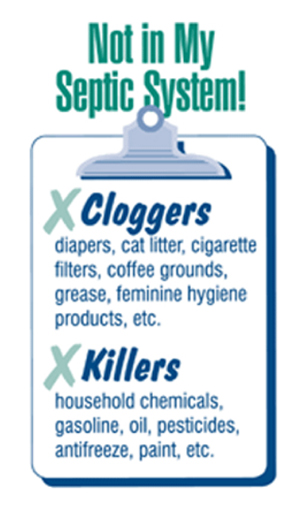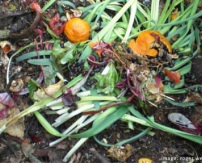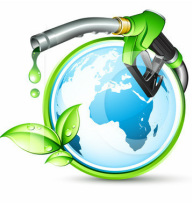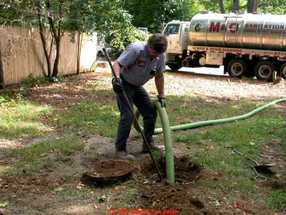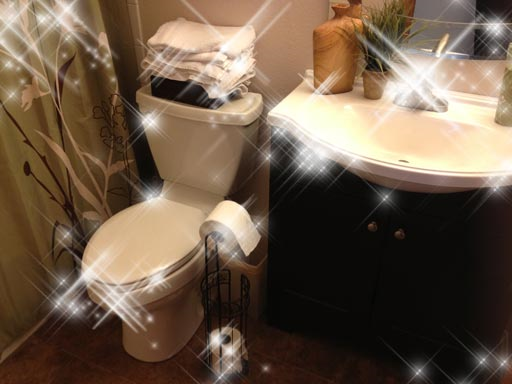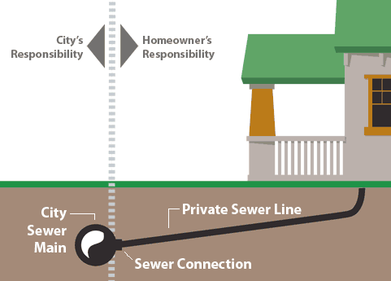 Home owner's SEPTIC responsibility.
Home owner's SEPTIC responsibility.
Can a Septic system be 'green'?
Yes, it can easily be done. The home septic system is normally composed of only two basic components: A septic tank and a disposal area.
Each is an integral function in the treatment & disposal of domestic wastewater resulting from laundry and bathing, kitchen wastes and body wastes. This relatively simple system of wastewater renovation can effectively remove disease-causing pathogens and chemical nutrients from domestic wastewater for the life of the home when properly designed, constructed, operated and maintained. So how do you properly maintain an existing septic system? Answer -Quickly Go Green!
Sewage which enters the septic tank is retained for a short time during which it breaks down into scum, sludge and liquid effluent. Most solid matter will settle to the bottom as sludge while buoyant grease, fats and hair will float to the surface and form a scum layer. Between these two layers is a clear liquid effluent which drains into the disposal area. The solids in the tank will be digested and converted into gases by microorganisms such as bacteria. This bacterium needs a “green” environment to function & do their job properly.
Its your responsibility as the homeowner, to ensure the bacteria happy & healthy, and not inadvertently destroyed.
Don't send bacteria-killing toxins down the drain. These include: Drain cleaners, antibacterial soaps, disinfectants, bleaches-whiteners, discarded medications and the worse one-paint! These will clogs both the septic tank & disposal area, and kill the working bacteria.
Don't send anything down the drain that can’t be broken down. These will clog the disposal area resulting in premature failure of your septic system . Cooking grease, cigarette butts, paints, coffee grinds and feminine products, cat litter, etc.
Keep your pool backwash water well away from our sewerage system-Chlorine will destroy the bacteria required by he septic tank to function
Keep Non-Degradable products well away from your system: Grease, disposable diapers, plastics, cigarettes, baby wipes, feminine products, cat litter, cotton balls/swabs, dental floss, medications/vitamins, lint and hair.
Poisons: Gasoline, oil, paint thinner, paint, pesticides, antifreeze, bleach, mop water, drain cleaners.
Yes, it can easily be done. The home septic system is normally composed of only two basic components: A septic tank and a disposal area.
Each is an integral function in the treatment & disposal of domestic wastewater resulting from laundry and bathing, kitchen wastes and body wastes. This relatively simple system of wastewater renovation can effectively remove disease-causing pathogens and chemical nutrients from domestic wastewater for the life of the home when properly designed, constructed, operated and maintained. So how do you properly maintain an existing septic system? Answer -Quickly Go Green!
Sewage which enters the septic tank is retained for a short time during which it breaks down into scum, sludge and liquid effluent. Most solid matter will settle to the bottom as sludge while buoyant grease, fats and hair will float to the surface and form a scum layer. Between these two layers is a clear liquid effluent which drains into the disposal area. The solids in the tank will be digested and converted into gases by microorganisms such as bacteria. This bacterium needs a “green” environment to function & do their job properly.
Its your responsibility as the homeowner, to ensure the bacteria happy & healthy, and not inadvertently destroyed.
Don't send bacteria-killing toxins down the drain. These include: Drain cleaners, antibacterial soaps, disinfectants, bleaches-whiteners, discarded medications and the worse one-paint! These will clogs both the septic tank & disposal area, and kill the working bacteria.
Don't send anything down the drain that can’t be broken down. These will clog the disposal area resulting in premature failure of your septic system . Cooking grease, cigarette butts, paints, coffee grinds and feminine products, cat litter, etc.
Keep your pool backwash water well away from our sewerage system-Chlorine will destroy the bacteria required by he septic tank to function
Keep Non-Degradable products well away from your system: Grease, disposable diapers, plastics, cigarettes, baby wipes, feminine products, cat litter, cotton balls/swabs, dental floss, medications/vitamins, lint and hair.
Poisons: Gasoline, oil, paint thinner, paint, pesticides, antifreeze, bleach, mop water, drain cleaners.
CONVERTING to a 'green' way of living is not difficult, and can save money in short term, but will definitely save you money in the long term. Required for a cleaner world, for the environment, and for pets and loved ones.
Modern detergents Environmental impact - After bubbly cleaning liquids disappear down our drains, they are treated along with sewage and other waste water at municipal treatment plants, then discharged into nearby waterways. Most ingredients in chemical cleaners break down into harmless substances during treatment or soon afterward. Others, however, do not, threatening water quality or fish and other wildlife. In a May 2002 study of contaminants in stream water samples across the country, the U.S. Geological Survey found persistent detergent metabolites in 69% of streams tested. Sixty-six percent contained disinfectants
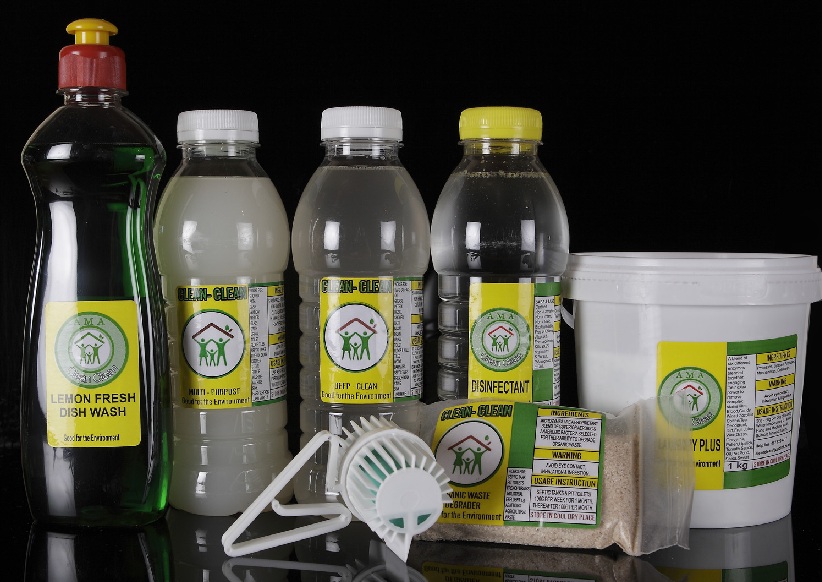
This household pack (COMBO PACK) has all the required DISHWASHING LIQUID, DETERGENTS, WASHING POWDERS, DISINFECTANTS and TOILET CLEANERS, which the average household's will use in a month. This will QUICKLY convert your home to a "GREEN HOT SPOT" environmentally friendly, healthy and you will be continually feeding your septic tank or your municipality sewerage system.
Septic Tanks - List of Do's & Don'ts
All the DON'Ts
Detergents are still much cheaper to manufacture than true soaps, and marketing has ensured that a majority of the population is absolutely convinced that detergents are safe to use. But consumers need to be educated that Bacteria/Enzyme products are more economical, due to concentration and growth of the product when activated Would you be surprised to learn that the vast majority (greater than 80%) have never been tested? And the majority of the others have been tested only by the manufacturer and not an independent testing laboratory?
Hidden Ingredients What’s even more is disturbing is that they are not legally required to list their ingredients on the labels. While these chemicals may not be on the label, recent studies show many of them to be proven lethal toxins. They build up in your skin, and may cause many serious health problems such as asthma, autism, infertility, allergies, and even cancer. 
Flushing cigarettes is a common, costly error when it comes to septic systems. The tightly woven filters do not break down and decay.
Cigarette butts float too and can cause clogging in your pipes and septic systems if the proper filtration tools are not in place. To keep it safe, do not dispose of cigarettes and many other commonly misplaced items in your septic system and avoid the regrettable possibilities. 
Think at the Sink! Your septic system contains a collection of living organisms that digest and treat household waste. Pouring toxins down your drain can kill these organisms and harm your septic system. Whether you’re at the kitchen sink, bathtub, or utility sink:
Avoid chemical drain openers for a clogged rain. Instead, use boiling water or a drain snake.

Regular kitty litters that consists of clay or inorganic compounds that destroy y bacteria and are bad for a septic system. The biodegradable litters obtainable wouldn't be as harmful, but its more expensive. Considering that human poop and toilet paper are sent into the septic system and the litters that I mentioned are totally biodegradable...in small quantities they might do any harm.
Reality is - Septic systems are a no go for flushable litter. Septic systems are just not made to handle flushable litter. Yes, you can use the flushable litter in a septic system, but it's just a matter of time before you get clogged pipes. I know a lot of the flushable litter companies claim that their litter is "septic safe". Don't believe them. You'll end up with an expensive plumbing bill at some point. Remember, flushable litter is about making your life easier. Clogged pipes and big plumbing bills are the exact opposite of making your life easier, and at the time the last thing you will lame is the easy flushable Kitty litter. A few more DANGEROUSE Septic Tank killers are listed below. Chemicals and toxins destroy good bacteria. A septic tank can only work if it is enriched with good bacteria and enzymes. OWD powder on a monthly basis will rejuvenate your system every month.
|
All the DO's
When enzymes are added to laundry detergent, it adds a major boost of the cleaning power. Enzyme washing is better on the environment than the use of chemicals to wash clothes, because enzymes are biodegradable, so they break down instead of remaining in the water supply. Enzymes also work well with cold water, which can reduce one's energy bill. Hot water is not necessarily needed to remove stains.
The high concentration of enzymes means that less detergent can be used per load of laundry, which also saves money. Going green & build your septic tanks
Do use substitutes for household hazardous waste. Replace the following hazardous products with products that are less environmentally harmful. The hazardous cleaners are listed below, followed by the suggested substitute:
Ammonia-based cleaners Avoid Totally. As replacement - for surfaces, use a solution of 1 cap Multi Purpose/Deep Clean in 1 litre spray bottle. Place the mixture into the spray bottle. Let stand for 20mins. Laundry detergents- Choose one with a zero phosphate content. All AMA Clean Clean products are all safe for clothing and laundry . Laundry Plus is a bacteria/enzyme based product , safe and BENIFICIAL to enhance your septic & French drain systems. For windows, use a solution of 1 cap Multi Purpose/Deep Clean in 1 litre spray bottle. Place the mixture into the spray bottle. Let stand for 20mins. Spray windows, leave on and let it work. Wipe down with clean cloth. No vigorous rubbing needed. REMOVES SHOWER SCALE Disinfectants Use Disinfectant - 1 cap in in 1 litre spray bottle. Place the mixture into the spray bottle. Let stand for 20mins; disinfects and deodorizes also. Do not pour into water system, it will destroy bacteria in your system, dispose of in the garden. Drain decloggers - Use AMA Clean Clean Organic Waste Degrader(OWD), no digging or using a plunger, metal snake, or removing of tank lid ever again. Scouring cleaners and powders Use 1 cap AMA Deep Clean in 1 litre Spray bottle of water. Spray on area, leave to work for 10 mins. wipe off, scour with abrasive sponge, no hard scouring required . It's cheaper and won't scratch. Carpet and Upholstery cleaners - Use 1 cap Multi Purpose/Deep Clean in 1 litre Spray bottle of water. Spray on area, leave to work for 10 mins. then vacuum. For tougher stains, spray a little more and repeat 5 mins later. Clean as normal, using AMA Clean Clean products in your carpet cleaning machine or bucket. Toilet cleaners Use AMA Toilet Rim lock. The bacteria will be constantly working in the bowl and work away at all organic matter stains. To scrub dirt/spoils, use Multi Purpose/Deep Clean, use 1 cap full in a bucket of water (5 litres) or in a 1 litre spray bottle. Spray on soils, leave for a few mins and clean. Organic soils will be eaten away and odour removed. Furniture and floor polishes-To clean, Use 1 cap Multi Purpose/Deep Clean in 1 litre Spray bottle of water. Dry with soft cloth. Polish with 1 part lemon juice and 2 parts oil (any kind), or use natural products with lemon oil or beeswax in mineral oil. Metal cleaners Brass and copper: To clean, Use 1 cap Multi Purpose/Deep Clean in 1 litre Spray bottle of water. Dry with soft loth. Stainless steel:Use 1 cap Multi Purpose/Deep Clean in 1 litre Spray bottle of water. Use scouring pad and a soft wet cloth for hard packed soils. Oven cleaners Quickly sprinkle salt on drips, then scrub. Use baking soda and scouring pads on older spills. Or Use 1 cap Multi Purpose/Deep Clean in 1 litre Spray bottle of water. Use scouring pad and a soft wet cloth for hard packed soils. AMA Clean Clean products devour oils, dairy ovens are a build up of hard baked oils, no problem for a bacteria/enzyme cleaner. A useful link on - How to Care for a Septic System
|
For a healthier family & a healthy functioning Septic Tank, follow the rules of MOTHER NATURE |
Green, Eco Friendly, Organic, Biodegradable - all feed and make for a "hungry" Septic Tank |
ATENTION !
|


